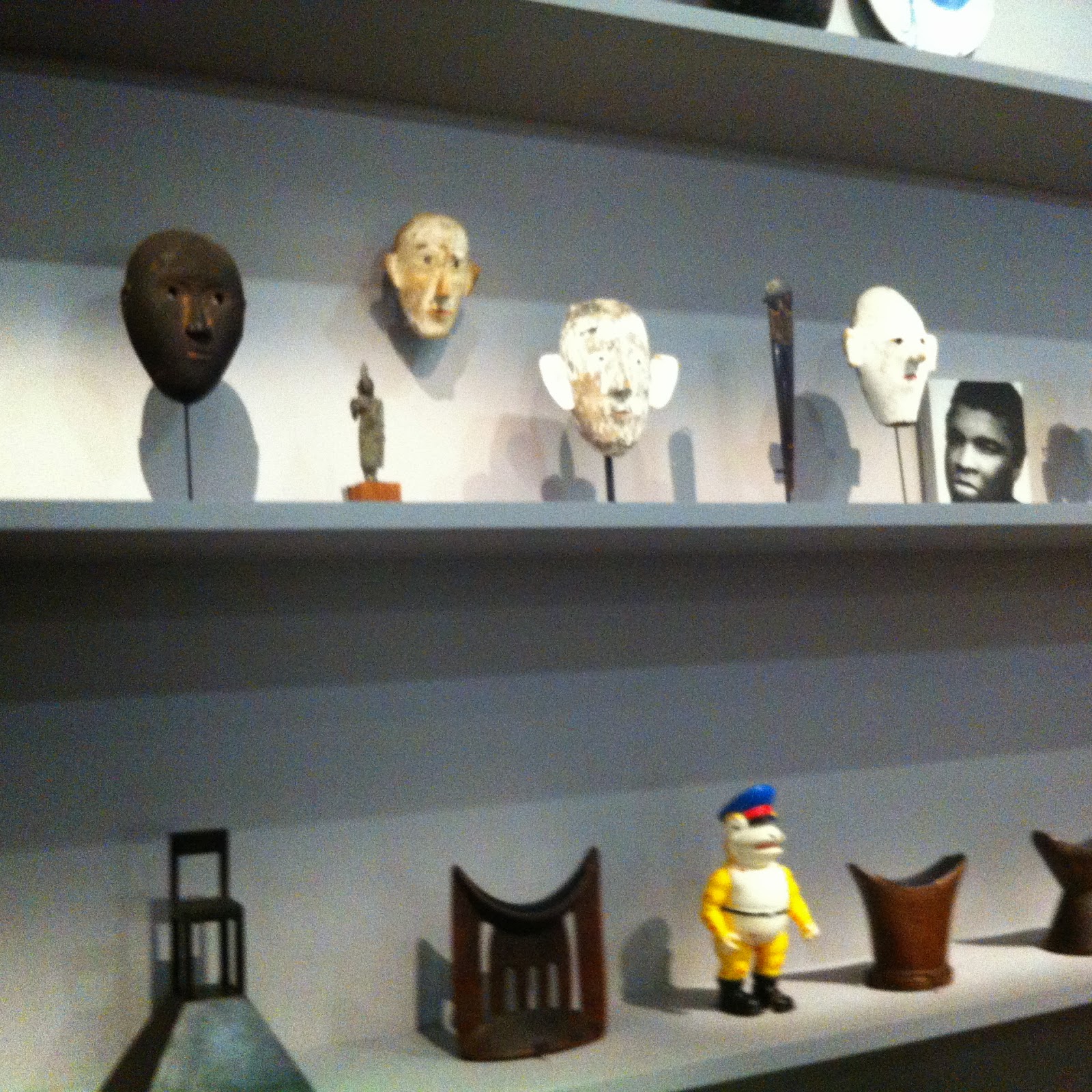 |
| Robert Wilson, Shaker Chair, Living Rooms, 2013 |
In keeping with their tradition of inviting contemporary
artists to engage with and use the works in its collection, the Louvre is
currently displaying Robert Wilson –
Living Rooms. Wilson, the renowned American Minimalist theatre director, accepted
the invitation, turned it on its head, and then inside out. He moved his own art
collection into the Louvre instead of working with theirs as every other artist
has done. Wilson has organized his belongings in La Salle de la Chapelle, covering the walls from floor to ceiling
with artworks, ephemera, masks and totems from native cultures, and
memorabilia. In the centre of the space is his bed with a compelling video with
Lady Gaga at its foot and a collection of native figurines at its head. All the
objects in La Salle de la Chapelle are
precisely placed, often being put behind glass and in vitrines in spite of
their apparent mundanity.
 |
| Robert Wilson, Living Rooms, 2013 |
While I understand the references to surrealism, most
significantly André Breton’s collection of art and ethnographic material, I was
unsure of how to approach the display, what to make of it. I wasn’t sure of what
I was being asked to look at? Usually, when we see inside someone’s collection
of art or trinkets, we gain privileged access to the personality who collects.
Or, as is the case with Breton’s collection, unknown, unappreciated objects are
given new light, energy and contexts. Alternatively, the collection itself
becomes a work of art, as we know so well from Joseph Cornell’s boxes. But at
the Louvre, there’s little to learn about Wilson that we don’t already know, and
although some of the Alaskan artefacts are interesting, there’s not a
consistent or overall lesson, even impression, to be gleaned from their
collection by Wilson. As a result, it is fun to see Marlene Dietrich's used shoes
on display, or an anonymous photograph of Albert Einstein, but their appeal as
curiosities only goes so far.
 |
| Marlene Dietrih's Shoes, in Living Rooms, 2013 |
In two other spaces — Le salon Denon, the heart of the great
French paintings of the the 19th century, and la Salle de la Maquette
in the subterranean Medieval wing — are a collection of Video Portraits of Lady Gaga.
For these works, films Lady Gaga in video performances of Andrea Solario’s The Head of John the Baptist on a Charger, 1507, the Neoclassic painting by
Jacques-Louis David, The Death of Marat, 1793, and Mademoiselle Caroline Rivière, 1793-1807 by Jean-Auguste-Dominique Ingres.
Robert Wilson, Mademoiselle Caroline Rivière
by Jean August Dominique Ingres, 2013
Although I am impressed by Wilson’s translation of one
medium to another, here painting to video, I was left asking the same questions.
What exactly am I looking at? How am I being asked to approach these
installations. I kept wondering why these, again very deliberate and precisely
framed, images are titled Video Portraits
of Lady Gaga? What do they have
to do with her? Other than the fact that she is the actor in the image, what
role has she played in the production of the video re-enactments? What does her presence say about France’s
heritage in painting?
 Robert Wilson, Video Portrait of Lady Gaga as Marat from The Death of Marat by Jaques Louis David, 2013 |
If there is some comment on or engagement with the images
that are re-enacted, Wilson’s use of Lady Gaga is even more disturbing. That
Lady Gaga literally becomes the revolutionary in The Death of Marat nonchalantly hanging amid the great works of
French painting might be said to turn this heritage into a “celebrity culture,”
but I am not sure I agree with Wilson on that score. The transgender performer
Lady Gaga turns enigmas that have perplexed art historians for years into camp
glamour. I also wonder what Wilson’s re-enactments have to say about video art
today? Especially when the videos look as though they were made by Bill Viola,
which is to say, there is nothing new or formally innovative in Wilson’s
videos.
Ultimately, I was disappointed by Robert Wilson — Living Rooms: it turned out to be a very hedonistic
installation on a number of levels. Not only because unlike every other
contemporary artist who has been invited to exhibit at the Louvre, Wilson seems
to disregard the vast collection of the Museum, preferring his own creations.
But also, because other of Wilson’s contributions to the Paris cultural scene
this winter were outstanding. It’s no secret that Wilson is an artist who still
has the capacity to push the boundaries of theatre in exciting ways. And yet, in
his exhibition for the Louvre, in what must be a great honour for a
contemporary artist, Wilson neither surprises nor challenges his audience.

No comments:
Post a Comment